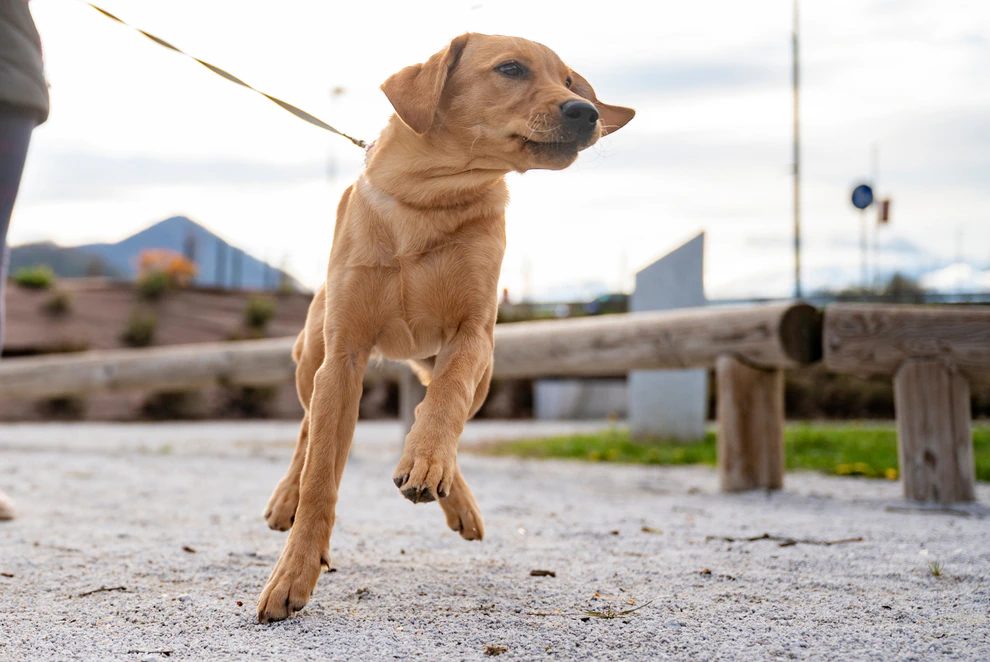You’re Not Alone in Dealing with Behaviour Issues
Facing behaviour problems is shite, let’s just call a spade a spade. It’s often overwhelming, frustrating and, at times, super isolating… ‘Why is it just me..?’. It can be a dog barking excessively out the window, destroying your sofa and clothes, or showing signs of anxiety or aggression when you drop the kids off at school. Many owners worry they’re doing something wrong or that their dog is beyond help. The truth is, you’re not alone. Behaviour issues are incredibly common among dogs of all breeds and ages, with studies showing that +70% of dogs experience some form of behavioural problem during their lifetime. So actually, you are in the majority!
These challenges strain the relationship between you and your pet, because you feel like your living with “Dr. Jekyll and Mr. Hyde”. They are the best dog at home, and a devil outside, or they are the best dog except when they see a white van… then all bets are off. It’s important to remember that behaviour problems are not a reflection of your capabilities as an owner. Often, these behaviours stem from natural instincts, fear, or environmental stressors, and they can be addressed with the right approach. By understanding the root causes and applying proven, science-backed methods, you can support your dog in overcoming these difficulties and get more Jekyll, less Hyde.
Common behavioural Issues in Dogs
Behavioural challenges are not only common in dogs, but they also manifest in a variety of ways that often seem like ’their little quirk’ as it feels like it doesn’t fit into the normal. While they are often strange and wide-ranging, understanding the most frequent problems can help you identify what your dog might be experiencing.
Separation Anxiety
Separation anxiety, or what we now call ‘separation related behaviours’, is one of the most commonly reported behavioural problems in our dogs. The range of behaviours — from barking, urination/defecation in the home, to destruction of household items — affects approximately 20-40% of dogs. We call it ‘separation related behaviours’ because dogs might perform destructive behaviours, bark excessively, or become overly anxious when their owners leave the house, and the cause is separation from their people. This issue stems from a deep sense of attachment, also known as attachment theory, and these behaviours can be distressing for both the dog and the owner. Separation Anxiety in Dogs: Understanding the Causes and Finding Solutions
Aggression Towards People or Other Animals
Aggression behaviours, or distance increasing behaviours, are a serious concern for many dog owners. Not only because they are scary, but also can have legal implications if not managed correctly. It can present as growling, lunging, barking, snapping, or biting, and may be directed at strangers, other dogs, or even family members. Research suggests that around 19% of dogs display aggression towards other animals or humans at some point in their lives. This type of behaviour is often rooted in fear, territorial instincts, or lack of socialisation. The Root Causes of Aggression in Dogs
Excessive Barking
Dogs naturally bark as a form of communication, but (big but) they aren’t vocal communicators like we are. If you look at how dogs communicate with each other, most of it is body language and very little vocalisation, unless they want to alert other dogs to danger or chase, or create distance with a growl. So when barking becomes excessive, it’s a clear sign that something is off. Whether it’s due to boredom, anxiety, under-stimulation, over-stimulation, or attention-seeking, excessive barking is a common complaint among dog owners. Identifying the underlying cause is key to addressing this issue. Help! My Dog Is Barking and Won’t Stop!!
Destructive behaviour
Chewing furniture, digging up the yard, or tearing apart household items are all signs of destructive behaviour. Yes, dogs like to chew, but this is not a normal behaviour when it involves non-food items. Dogs don’t naturally want to chew items that are not edible; when they do, this condition is known as ‘pica’. Destructive behaviour is often a result of pent-up energy, under-stimulation, anxiety, nutritional issues, gastric problems, or lack of proper mental stimulation. Studies show that up to 30% of dogs engage in some form of destructive behaviour, particularly in the post-adoption phase.
Fear and Phobias
Fear-based behaviours, which are also linked to separation-related behaviours and aggressive behaviours, can include trembling, hiding or avoidance behaviours, as well as reactive aggression. They can be triggered by various factors like loud noises, unfamiliar environments, or negative past experiences. Many dogs struggle with specific phobias, such as thunderstorms or noise anxiety, and without proper support, these fears can escalate into more severe behavioural issues.
This has been a very high-level overview of some of the main issues. I’ve linked above to other blogs (with a blog-cast) that go into these particular issues in depth.
Why These behaviours Occur
Understanding why dogs exhibit certain behaviours is key to addressing them effectively—if we don’t know why or what is causing them, we might apply the wrong treatment. Take for example if you go into your doctor with a bad cough and they give you antibiotics, but you actually have a viral infection—this is the wrong treatment. Many common behavioural issues stem from a combination of genetics, environment, past experience, the dog’s mental health needs, and emotional responses to all of the above. Getting to the root cause can help us to better empathise with our dog’s situation and take informed steps to manage and modify their behaviour.
Fear is a primary driver of many behavioural problems, including aggression, barking, and destructive behaviour. Dogs may develop anxiety due to a lack of early socialisation, traumatic experiences, or even genetic predisposition. For example, dogs that are under-socialised during their critical development period are more likely to react fearfully to new people, environments, or other animals. Separation anxiety, in particular, often arises from a strong attachment to the owner and the dog’s inability to cope when left alone.
Dogs are intelligent and energetic animals that require regular mental and physical stimulation. Without enough exercise or activities to engage their minds, they can become bored and frustrated, leading to destructive behaviour, excessive barking, or even aggression. Research shows that many dogs, particularly those left alone for long periods, engage in destructive behaviours simply as a way to release pent-up energy.
Certain breeds are more prone to specific behavioural issues due to their genetic makeup. For example, herding breeds like Border Collies may exhibit excessive barking or nipping, as these behaviours align with their instinctual drive to herd. Similarly, guarding breeds may show a tendency toward territorial aggression. While genetics play a role, it’s important to remember that individual training and socialisation have a significant impact on managing these tendencies.
Dogs thrive on consistency, and when training or boundaries are unclear, they can develop problematic behaviours. Inconsistent cues/asks, mixed messages from different family members, or the use of punishment-based training can lead to confusion and anxiety in dogs. Dogs respond best to positive reinforcement, where good behaviour is rewarded, helping them understand what’s expected of them in a clear, constructive way.
Dogs that have experienced trauma, neglect, or harsh treatment are more likely to develop behavioural issues, particularly aggression and anxiety. Rescue dogs, in particular, may have histories that include abuse or neglect, making them more fearful and reactive in certain situations. These dogs often need patience, understanding, and specialised behavioural support to help them overcome their past experiences.
By understanding the reasons behind these behaviours, we can see that they are often normal responses to stress, fear, or unmet needs. The good news is that with the right approach, these behaviours can be managed and improved.
How to Support Your Dog
Once we understand the reasons behind our dog’s behaviour, the next step is finding the most effective way to support them. Research shows that using compassionate, science-backed methods not only improves your dog’s behaviour but also strengthens the bond between you and your pet. Critically, this behaviour modification training allows the dog to communicate back, which helps us tweak and tailor the response according to their needs.
Positive reinforcement is one of the most effective training methods for addressing behavioural issues. This technique focuses on rewarding your dog for the desired behaviour, encouraging them to repeat those actions. Research consistently shows that dogs trained with positive reinforcement are more likely to develop good habits and less likely to show fear or anxiety.
For example, if your dog struggles with excessive barking, rewarding them when they’re quiet or can disengage teaches them that calm behaviour leads to positive outcomes. Over time, this helps reduce the unwanted behaviour without resorting to punishment, which can increase fear and aggression.
A well-exercised dog is a happy dog. Ensuring your dog gets regular physical activity and mental stimulation can prevent many behaviour problems from occurring. Interactive toys, puzzle feeders, or even a game of fetch can help burn off excess energy and keep your dog engaged. Dogs that don’t get enough stimulation often turn to destructive behaviours like chewing furniture or excessive barking. By providing them with structured play, walks, or problem-solving games, you help fulfil their natural instincts and reduce frustration. On the flip side, dogs that are over-exercised or overstimulated can become restless or reactive, so balance is key.
For dogs that exhibit fear-based behaviours, such as aggression or anxiety, systematic Desensitisation and counter-conditioning (SDCC) are highly effective techniques. Systematic Desensitisation (SD) involves gradually exposing your dog to the thing they fear in a controlled, non-threatening way and changing the emotional response over time. Counter-conditioning (CC) pairs that exposure with positive experiences, helping the dog form new, positive associations with their triggers.
If your dog is anxious around strangers, start by exposing them to strangers at a distance where they feel safe. Gradually decrease the distance, rewarding calm behaviour with treats or cuddles. Over time, your dog will learn to associate strangers with positive experiences, reducing their anxiety.
Consistency is key to helping your dog understand what’s expected of them in given situations. Inconsistent training or unclear boundaries/communication can confuse your dog and lead to increased anxiety or the feeling that they are not listening. By setting clear, consistent rules/communication and ensuring all family members follow the same expectations, you provide a stable environment for your dog. Keeping everyone happy!
Using consistent cues/asks, offering regular training sessions, and reinforcing the wanted behaviour helps your dog feel secure and confident in their place within the household.
In some cases, behavioural issues may require professional intervention. Dogs with severe anxiety, aggression, or trauma may benefit from working with a Certified Dog Trainer or Behaviourist/Clinical Animal Behaviourist who can create a tailored behaviour modification plan. These professionals use evidence-based methods to address specific issues and can help you navigate more complex challenges. Any good professional will list their qualifications and accreditations on their website, be clear and transparent, and never mind you asking them how they train.
Seeking professional help doesn’t mean you’ve failed—it’s a responsible step toward ensuring your dog’s well-being and safety. Whether through in-person sessions or virtual consultations, professional guidance can make a significant difference in managing difficult behaviours.
My Approach to Supporting You and Your Dog
At Bright Hound, I understand how challenging it can be to deal with behavioural issues in your dog, but you don’t have to face these challenges alone. I specialise in compassionate, science-based methods that address the root causes of your dog’s behaviour, ensuring lasting results and a stronger bond between you and your pet. Every dog is unique, and so are their behavioural needs. I offer personalised consultations where I assess your dog’s behaviour, environment, and triggers to develop a tailored training and behaviour modification plan. Whether your dog struggles with anxiety, aggression, or excessive barking, I create a step-by-step approach that suits their personality and your lifestyle. During our consultations, I take the time to explain the science behind your dog’s behaviour, giving you a deeper understanding of their needs and how to best support them. You’ll leave with actionable steps and a clear plan to help your dog thrive.
I am a firm believer in positive reinforcement, a proven method that focuses on rewarding good behaviour rather than punishing bad behaviour. My training sessions are designed to be fun, engaging, and effective, helping your dog learn in a stress-free environment. Because lets face it, we bring dogs into our lives to have fun! Whether it’s teaching basic cues/asks or addressing more complex behavioural issues like aggression or anxiety, I provide hands-on guidance and support. You’ll learn how to use rewards, consistency, and clear communication to transform your dog’s behaviour.
Behavioural change doesn’t happen overnight. Typically, we start with an initial 2‑hour 1:1 consultation to create your plan, and I usually recommend at least two follow‑up sessions to coach and troubleshoot. When it comes to animals it never goes exactly to plan, and we need to account for that. I’m always here to support you every step of the way—I never leave folks to the wolves. It is critical that after our initial consultation or training session, behaviourists offer ongoing support to ensure your dog is making progress. This should include follow‑up check‑ins, additional training sessions if needed, and adjustments to your behaviour plan based on your dog’s development.
My goal, and that of fellow behaviourists, is to create long-term success for both you and your dog. We should always be available to answer questions, troubleshoot challenges, and provide encouragement as you work toward a happier, more balanced life together.
For dogs with more severe behavioural issues, such as extreme fear, trauma, or aggression, I offer specialised behaviour modification programs. As a Clinical Animal Behaviourist, I work alongside your vet to ensure a complete picture of care. These programs are designed to address deep-seated problems through a combination of desensitisation, counter-conditioning, vet support, and consistent training. I work closely with you to ensure your dog receives the compassionate care they need to make real progress. At Bright Hound, I’m committed to helping you and your dog overcome any behavioural challenges you may face. With personalised support, positive reinforcement, and expert guidance, you can transform your dog’s behaviour and strengthen the bond you share. Contact me today to learn more about our services and how I can help your dog thrive.
5 Things Every Dog Guardian Should Know About Training & Behaviour
Does your dog pull on the lead, ignore you when you call, or jump on visitors? You’re not alone… These are some of the most common challenges guardians face — and they can leave you feeling frustrated, embarrassed, and unsure what to do next.
The good news? These behaviours aren’t signs that your dog is “stubborn” or “disobedient.” They’re simply ways of communicating. With the right approach, you can transform frustration into understanding and build a calmer, happier relationship with your dog.
My free guide, “5 Things Every Dog Guardian Should Know About Training & Behaviour”, will show you how. Inside, you’ll discover simple, science-based principles that explain why dogs do what they do — and how you can teach them new behaviours kindly and effectively.
This quick, compassionate checklist will help you:
- Understand why your dog repeats certain behaviours
- Learn the role of emotions in behaviour
- Use consistency and reinforcement to your advantage
Take the first steps toward easier walks, better recall, and calmer greetings
Sign up below to get your copy and receive a supportive 6-part email series with practical tips to help you and your dog feel more connected and confident together.
Reference List
- Gates, M. C., Zito, S., Thomas, J., & Dale, A. (2018). Post-Adoption Problem Behaviours in Adolescent and Adult Dogs Rehomed through a New Zealand Animal Shelter. Animals, 8(6), 93. [DOI:10.3390/ani8060093]
- Salonen, M., Vapalahti, K., Tiira, K., & Lohi, H. (2020). Inadequate socialisation, inactivity, and urban living environment are associated with social fearfulness in pet dogs. Scientific Reports, 10(1), 3527. [DOI:10.1038/s41598-020-59837-z]
- Tiira, K., Sulkama, S., & Lohi, H. (2016). Prevalence, comorbidity, and behavioral variation in canine anxiety. Journal of Veterinary Behavior, 16, 36-44. [DOI:10.1016/j.jveb.2016.04.008]




